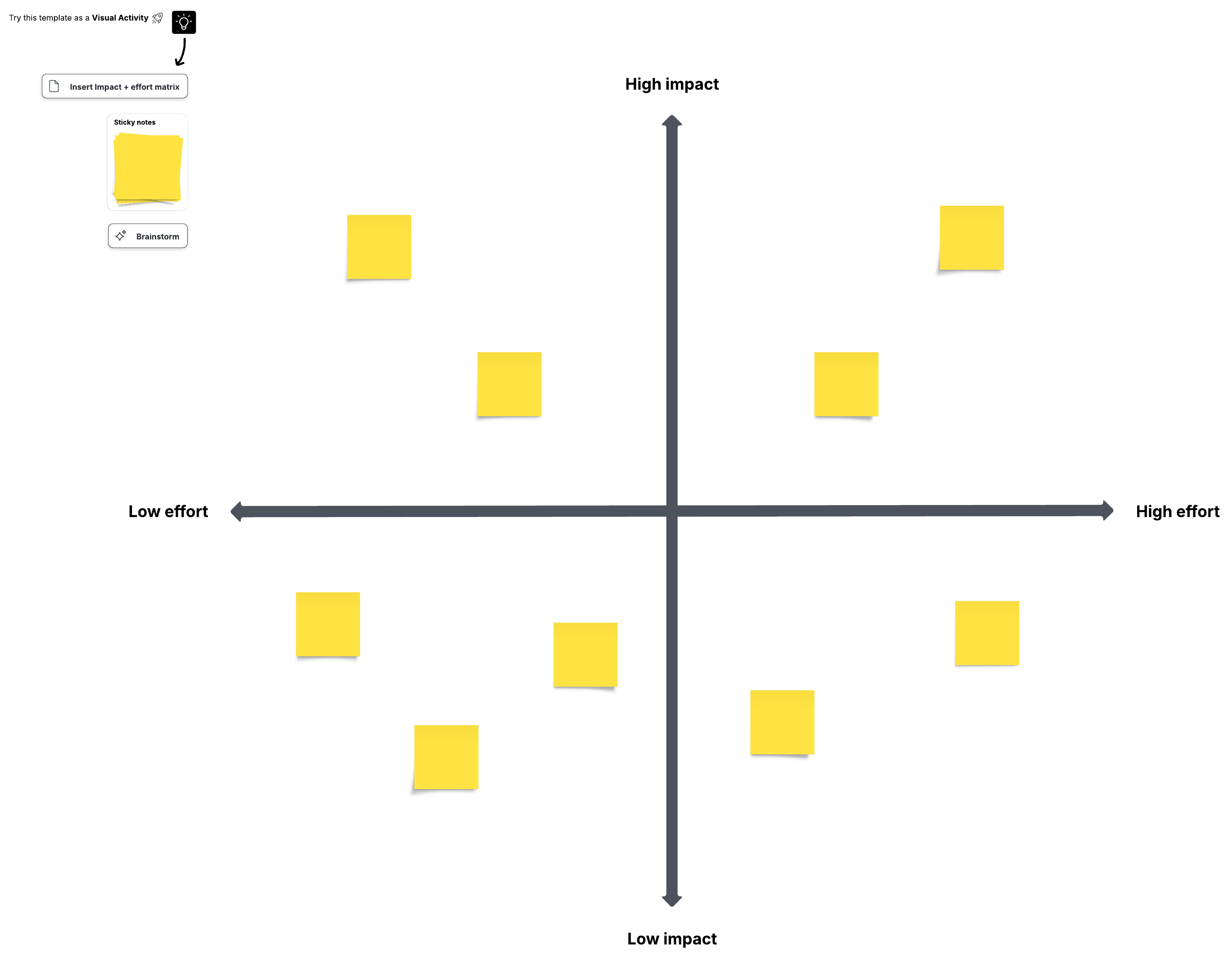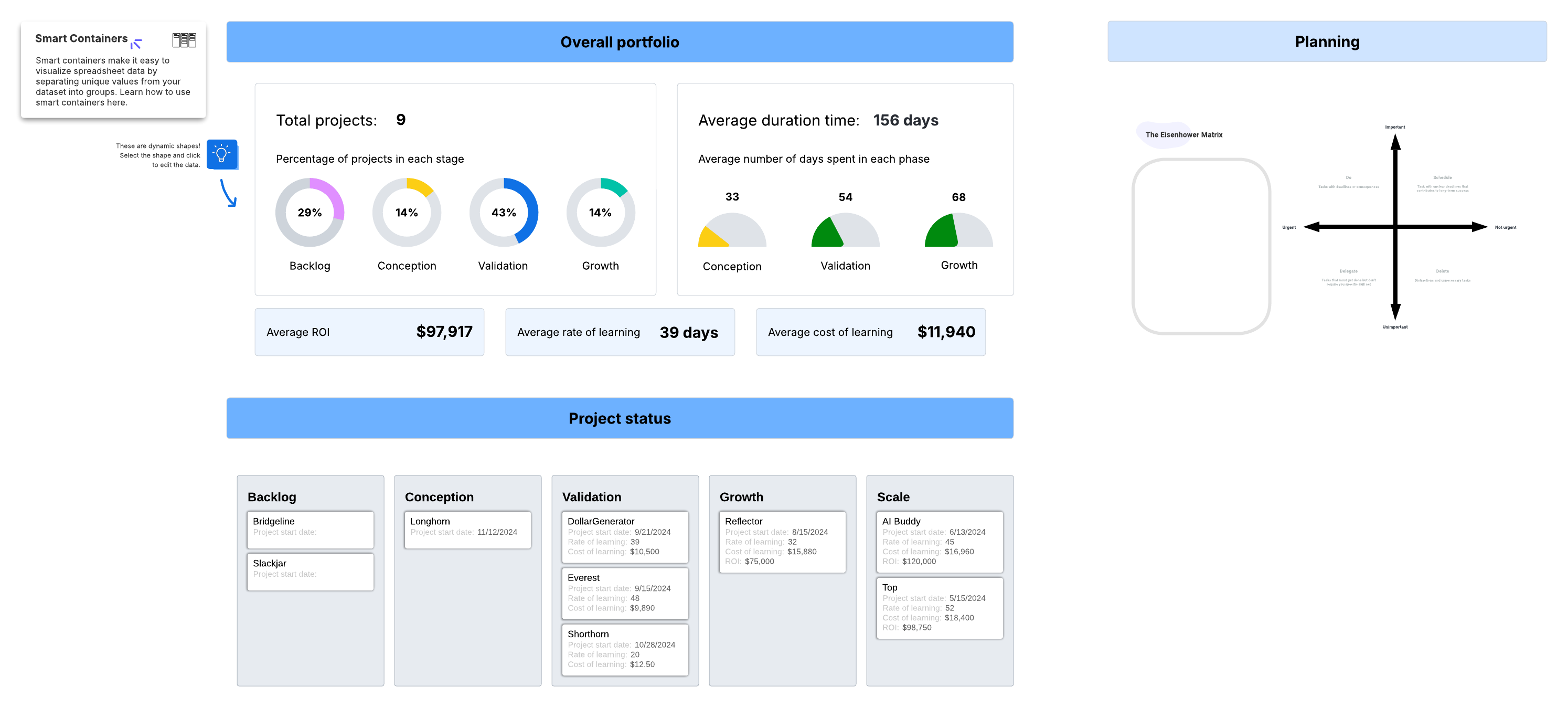
Five common barriers to innovation and tips to overcome them
Reading time: about 10 min
Topics:
Companies constantly talk about the importance of innovation, but when employees bring forward ideas, they often run straight into walls: Too many priorities, unclear processes, or no clear path to get buy-in. Barriers to innovation are a common frustration. In fact, according to the BCG’s 18th Annual Innovation Study, 83% of companies see innovation as a top priority, but only 3% of those companies are ready to deliver on innovation goals.
It’s one thing to set some aspiration to be more innovative as an organization, but it’s another thing to actually experience ROI from your efforts. The gap between aspiration and impact can be massive.
When you have all the right intentions but your innovation is going nowhere, what’s going wrong? In this blog post, we’ll break down the top five barriers to innovation in business and offer tactical tips on how to overcome them.
Overcoming challenges to innovation begins with your company culture
In order to actually practice and benefit from innovation, it’s important to establish a culture of innovation for your teams. Without an innovation culture in the first place, it’ll be difficult to overcome the blockers that people encounter.
Your company culture should encourage and reward innovative behaviors, including risk-taking, questioning the status quo, and cultivating unique perspectives. A culture of innovation allows great ideas to come from anyone, as all team members identify areas of improvement and champion change. Another key component to innovation is having a culture of psychological safety where employees feel comfortable taking risks and giving honest feedback.
With a thriving innovation culture, not only do new ideas emerge, but employees also feel more invested and have a greater sense of dedication.
To strengthen your innovation culture, look for these signals that your culture supports experimentation:
-
Leaders reward experimentation—even when it fails.
-
Teams have visible space in roadmaps for optional or exploratory work.
-
Employees feel comfortable asking questions and suggesting changes.
-
Recognition goes to those who improve how work gets done, not just those who “deliver more.”

Tips for creating a culture of innovation
Get actionable steps for cultivating an innovation culture in your workplace.
Read moreFive common barriers to innovation
Even with good intentions, sometimes innovation gets stuck. What barriers should leaders be aware of so innovation can be fostered more successfully?
The following are five of the most common barriers to innovation, according to Jeff Rosenbaugh, senior director of professional services at Lucid, and Christopher Bailey, director of consulting services at Lucid. During their time helping dozens of organizations become more innovative, Rosenbaugh and Bailey have seen these barriers limit success time and time again (and have proven strategies for overcoming each).
Difficulties in understanding priorities
One of the most common barriers to innovation is unclear priorities and business goals. There often are too many competing priorities and teams don’t understand how their work ties into the overall vision.
When priorities aren’t clearly defined, it’s more difficult for people to take a step back and identify opportunities where innovative solutions would be most impactful. Teams that see value from their innovation efforts intentionally leave room for introspection within the business process by allowing flexibility and attempting to avoid overcommitment.
To make priorities more clear, Bailey recommends applying the Pareto Principle: In this case, we commonly see 80% of business value come from 20% of work tasks. In order to get people more focused on work that’s really driving value, teams should deprioritize or cancel the work that doesn’t drive value early on. By identifying what to deprioritize early, this leaves more room for teams to focus and get creative.
“Without prioritizing, without managing and constraining the amount of tasks at any given time, we put our innovation potential in significant dire straits,” Bailey explains.
How to break down this innovation barrier
To break down this innovation barrier, make priorities and business goals clear in a way that’s documented and accessible to everyone. Provide teams with flexibility so they can establish a manageable cadence. Using prioritization activities such as an impact vs. effort matrix or a RICE prioritization matrix helps your team align and provides transparency into the work tasks that have the highest value. The key is to make these frameworks available and visible to everyone, so priorities don’t just live in leadership’s heads but become part of everyday decision-making.

Limiting innovation to certain teams
A major innovation myth is that innovation is limited to specific teams that are intentionally created to work on new technologies or new business ventures. In reality, anyone in any role can be innovative, and leaders should actively encourage innovative thinking across the board, especially for employees who work closely with customers.
“Part of [cultivating innovation] is recognizing where the information lives that will help you best improve your business. Oftentimes, that information lives where the customer experience is happening,” Bailey says. “You want the employees who are innovating to be the ones who are familiar with the customer’s perspective. That’s where a lot of that rich opportunity is discovered.”
In other words, the biggest potential for identifying innovation lies with the employees who are most deeply involved with the day-to-day workings of the business. Customer experience teams, sales teams, and support teams can more easily identify opportunities for improving the way the business provides value to customers.
How to break down this innovation barrier
Empower everyone to learn and practice innovation skills, such as designing experiments and sharing their findings. The more people share from experimentation, the more others can learn and practice themselves, encouraging the shift into a culture of innovation.
Employees at every level should seek out new opportunities and understand their customers’ problems. Again, when priorities and goals are clear, people can help steer the business in the right direction when the occasion arises.
Undervaluing certain types of innovation
Beyond limiting innovation to certain employees or people, many businesses limit themselves to only certain types of innovation, often unaware that there are different types in the first place. Innovation doesn’t always have to involve major changes that alter the entire company, which means that there are plenty of innovative opportunities that go ignored.
Developed by the Doblin Innovation Firm in Chicago, there are ten types of innovation that fall into three categories: Configuration (what goes on behind the scenes), offering (the product or service itself), and experience (customer-facing elements). Innovation isn’t just developing new operations strategies or coming up with an improved product; it can also involve leveraging networks or focusing on customer service.
Because we tend to think of innovation as those brand-altering, life-changing ideas, many people think that they’re not very innovative, which significantly limits innovative thinking.
How to break down this innovation barrier
To encourage people to identify different types of innovative opportunities, you can encourage your team to consider the following questions:
-
What could I do to level up the value of the tasks I’m working on?
-
Are there routine tasks I’ve never questioned before? How could my process of completing these tasks change?
-
Is there a way to tighten up a process or combine existing ones?
No matter what kind of tasks people are working on, there are always opportunities for innovation and divergent thinking; establishing this mindset goes a long way in fostering innovative solutions.
Missing expert input
Even the best ideas need the right context to take root. A common innovation barrier isn’t simply that leaders or experts are “too busy,” but that employees don’t have clear ways to engage those with deeper insight into the business.
Subject matter experts and business leaders often hold critical knowledge about organizational priorities, past innovation attempts, or hidden constraints that can shape raw ideas into viable solutions. Without their input, teams risk solving the wrong problem, duplicating past efforts, or pursuing ideas that don’t align with strategy.
“The most successful innovation happens when good ideas collide with deep context,” Rosenbaugh notes. “If there’s no way for employees to engage experts who understand the business, subject matter, and the company’s priorities, those ideas rarely reach their potential.”
This barrier often shows up as a disconnect between where ideas originate and where context lives. Employees closest to customers or daily operations surface creative solutions, but they may lack visibility into priorities, constraints, or past attempts. Without a clear way to bring those ideas together with expert insight, good intentions can stall—or worse, move forward in ways that create unnecessary rework.
When pathways for expert input don’t exist, employees may stop sharing altogether. Over time, innovation becomes siloed, and the organization loses the benefit of diverse perspectives that could have been refined into real breakthroughs.
How to break down this innovation barrier
To ensure opportunities for expert input, leaders can establish transparent decision-making processes that include readily-understood channels for people to be able to engage with them. These channels can include Slack channels, recurring meetings, or asynchronous collaboration opportunities.
It also helps to create a company-wide innovation process that clearly outlines when and how leaders or experts will be looped in as innovative ideas are validated. Employees should know when and how their ideas will be evaluated, and experts should know that their role is not to shut ideas down but to add the context that moves them forward.
By making engagement intentional, organizations ensure that promising ideas are refined early on and guided in the right direction. This accelerates progress, avoids wasted effort, and reinforces the message that innovation is everyone’s responsibility, supported by the wisdom of the whole organization.

Miscommunication about the value of innovation
Often, when teams need feedback or buy-in for an innovative idea, a barrier to success is that they don’t know how to communicate the value of their idea. They secure a meeting with stakeholders, and then struggle to get the message through about what should be changed and why.
This misalignment happens because teams need to tie their ideas for innovative projects to clear goals and be able to communicate the overall value at the portfolio level to secure funding or buy-in. It’s important for people—especially leaders—to understand how to measure innovation and communicate those metrics.
“I think the impetus is really on teams to find better ways to communicate the value that they’re trying to realize,” Rosenbaugh says. Some of that understanding comes from actual experience, so teams need time to experiment and show tangible results or otherwise be able to prove potential.
How to break down this innovation barrier
To overcome miscommunication about the value of innovation, it helps to understand which innovation KPIs to track. To communicate overall business value, metrics at the portfolio level include:
-
Percentage of projects in the conception, validation, and growth stages of innovation
-
Cycle time of projects in each stage
-
Number of assumptions validated
-
Average duration of projects in the pipeline
-
ROI from projects that have exited the pipeline
Awareness and understanding of these metrics is a great step toward securing leadership buy-in for innovation when the time comes.

Breaking down the barriers to innovation
Many companies want to be innovative and actively try to be, but once you encounter barriers, it’s easy to become discouraged. Understanding what’s getting in the way of your innovation is a key aspect of developing a systematic approach to truly becoming an innovative business. Once you’ve identified the innovation challenges that you tend to run into, you can begin to overcome them and take a major step toward fostering and implementing innovative ideas.

Get started on an innovation strategy
Learn how to build a comprehensive innovation strategy to help you overcome challenges to cultivating innovation.
Go nowAbout Lucid
Lucid Software is the leader in visual collaboration and work acceleration, helping teams see and build the future by turning ideas into reality. Its products include the Lucid Visual Collaboration Suite (Lucidchart and Lucidspark) and airfocus. The Lucid Visual Collaboration Suite, combined with powerful accelerators for business agility, cloud, and process transformation, empowers organizations to streamline work, foster alignment, and drive business transformation at scale. airfocus, an AI-powered product management and roadmapping platform, extends these capabilities by helping teams prioritize work, define product strategy, and align execution with business goals. The most used work acceleration platform by the Fortune 500, Lucid's solutions are trusted by more than 100 million users across enterprises worldwide, including Google, GE, and NBC Universal. Lucid partners with leaders such as Google, Atlassian, and Microsoft, and has received numerous awards for its products, growth, and workplace culture.
Related articles
The 10 types of innovation (and why you should implement them in your organization)
There are ten different types of innovation. To truly set your org apart, you'll need to adopt as many as possible.
What is an innovation culture?
With a thriving innovation culture, a business gains the catalyst it needs for continuous growth and progress. Learn how you can create one in your organization.
The top innovation skills for the workplace (with tips + templates)
Learn our top innovation skills to have in the workplace, with tips and templates to get you started.
How to measure innovation: Metrics that actually matter
Yes, you can measure innovation. Learn how from Lucid experts.
